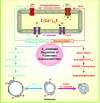Severe, Rapidly Reversible Hypoxemia in the Early Period after Bilateral Lung Transplantation
- PMID: 27295160
- PMCID: PMC5461991
- DOI: 10.1513/AnnalsATS.201602-107CC
Severe, Rapidly Reversible Hypoxemia in the Early Period after Bilateral Lung Transplantation
Figures





References
-
- Swenson ER. Hypoxic pulmonary vasoconstriction. High Alt Med Biol. 2013;14:101–110. - PubMed
-
- Robin ED, Theodore J, Burke CM, Oesterle SN, Fowler MB, Jamieson SW, Baldwin JC, Morris AJ, Hunt SA, Vankessel A, et al. Hypoxic pulmonary vasoconstriction persists in the human transplanted lung. Clin Sci (Lond) 1987;72:283–287. - PubMed
-
- von Euler US, Liljestrand G. Observations on the pulmonary arterial blood pressure in the cat. Acta Physiol Scand. 1946;12:301–320.
-
- Kregenow DA, Swenson ER. The lung and carbon dioxide: implications for permissive and therapeutic hypercapnia. Eur Respir J. 2002;20:6–11. - PubMed
MeSH terms
Grants and funding
LinkOut - more resources
Full Text Sources
Other Literature Sources
Medical

